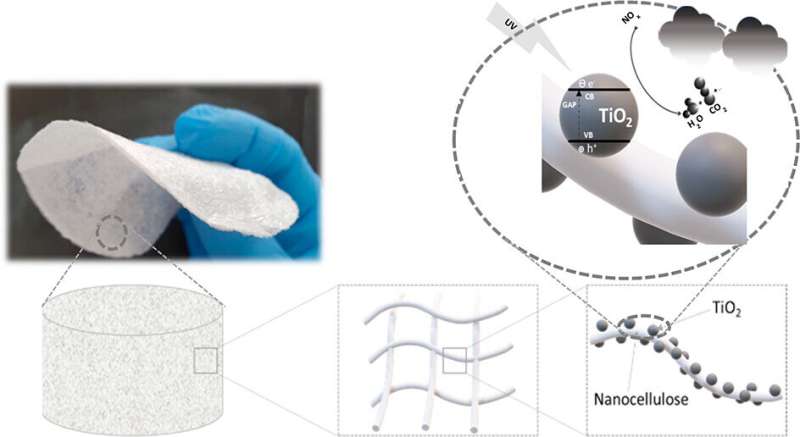This article has been reviewed according to Science X's editorial process and policies. Editors have highlighted the following attributes while ensuring the content's credibility:
fact-checked
trusted source
proofread
Converting agricultural waste into a material that cleans the air

The University of Cordoba has developed a biodegradable material, made with nanocellulose and photocatalytic particles, for the efficient decontamination of urban air.
Air pollution and its high concentration in cities is one of the problems facing society today, due to its harmful effects on the environment, but also on human health. One of the causes of this pollution is the increase in nitrogen oxide emissions, mainly due to the use of fossil fuels.
While the emissions of these gases are being reduced, photocatalysis is proving to be a tool for decontaminating air in cities: materials called semiconductors are created which, when coming into contact with the pollutant, under the effect of ultraviolet light, cause it to degrade, thus reducing its concentration in the air.
Two research groups of the University of Cordoba, belonging to the Chemical Institute for Energy and the Environment (IQUEMA),and the Department of Inorganic Chemistry and Chemical Engineering, have been working to produce these materials. The team, formed by the BioPrEn and Inorganic Chemistry groups, has obtained biodegradable materials to fix nanoparticles with photocatalytic activity (in this case, titanium dioxide), augmenting the power and, therefore, the decontaminating effect.
The advances made by this work consist of "first, the creation of a biodegradable medium based on nanocellulose, obtained from agricultural waste; and, second, the development of a surface modification process of these nanoparticles, which results on their greater dispersion and immobilization, and, therefore, enhanced photocatalytic activity," explains one of the authors of the article, researcher Eduardo Espinosa.
The progress is twofold: it is possible to create a sustainable material by recovering a form of agricultural waste(thus contributing to the Circular Economy) and the process of fixing photocatalytic nanoparticles to this biodegradable medium is simplified. The benefit is, in fact, exponential, since the result is greater air decontamination due to the porosity and the three-dimensional nature of the material, which means that more photocatalytic particles are exposed to ultraviolet light compared to an opaque material or one in which only one surface is exposed to light.
What is it like? Where is it used?
Those who see this material will recognize a light, solid foam, but with very little density, similar to insulation coverings used in construction, or the popular corn "puffs." To effect decontamination "it can be used as a porous filter through which the gas stream passes, always exposed to ultraviolet light, and the gas comes out decontaminated," says Espinosa. Thus, gases released by industry, for example, would come out almost clean of nitrogen oxides.
A further step in this research would be to modify the photocatalytic particle so that it is more sensitive to light from the visible spectrum, without having to resort to ultraviolet sources. In this way the photocatalytic power would be activated by sunlight alone, and this type of technology could be applied to textiles and other types of materials, thereby reducing the concentration of gases only through exposure to the sun.
The study is published in the journal ACS Sustainable Chemistry & Engineering.
More information: Sergio Carrasco et al, Simple Route to Prepare Composite Nanocellulose Aerogels: A Case of Photocatalytic De-NOx Materials Application, ACS Sustainable Chemistry & Engineering (2023). DOI: 10.1021/acssuschemeng.2c06170
Provided by University of Córdoba




















